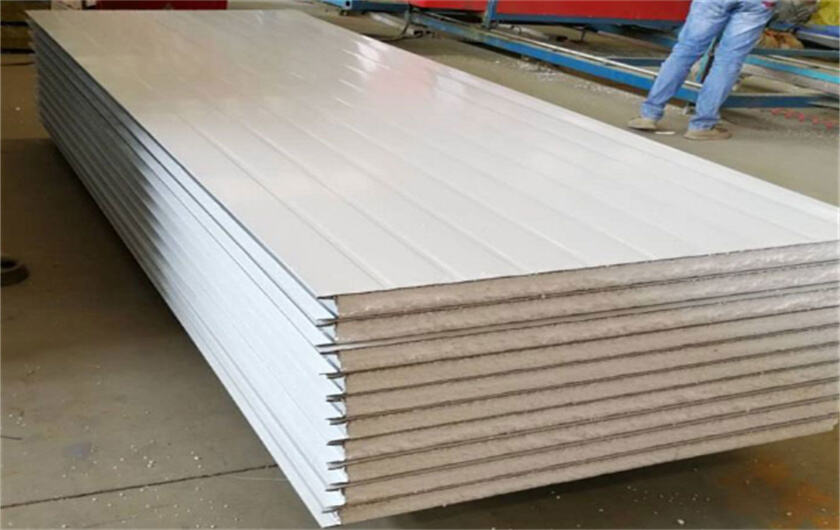Introduction
With several features like aesthetics, versatility and efficiency to offer, sandwich panels have grown over the years to revolutionise the construction industry. With an insulating core material held between two layers of board, these panels provide many benefits which are useful for the relevance of its building use. This article gives an overview of sandwich panels, their composition, manufacturing processes, advantages, applications and maintenance requirements.
Composition of Sandwich Panels
Sandwich panels are made of the following three main components: core material, facing or skins, and adhesive. This core is usually composed of steel, expanded polystyrene (EPS), extruded polystyrene(XPS) board, polyurethane (PU) or mineral wool which are great thermal insulation. They can consist of metals like aluminium or steel, fiberglass or Glass Reinforced Concrete (GRC) providing strength and durability. These may include a choice of materials based on whether the application is seeking for things like fire resistance, impact resistance, or even aesthetic quality.
Manufacturing Process
Sandwich panels are manufactured by neatly cutting and forming the core material with high precision, and applying adhesives to bond the facings. At this stage, it is essential that quality control measures are taken to ensure the panels will be structurally sound as well as provide adequate insulation. Brent wood's numerous options for customization, such as different core thickness and finishing of the facings, makes it easy to customize solutions to fit each project perfectly.
Benefits of Sandwich Panels
This is why Sandwich panels are popular in construction, as they have many advantages. They have a good insulation properties to the cold, therefore they are energy-saving (heating and cooling). They are light, which makes them easy to handle and also helps facilitate a quick and simple installation process in terms of being structural – inherently strong yet stable. Ideally, sandwich panels are versatile in visual design with various colour, textures and finishes באליפות עולם 2023. They are also very economical, especially when you factor in their energy savings over the long-term and the low maintenance costs.
Uses of Sandwich Panels
Sandwich panels are highly versatile, and can be used for countless applications. They are found in commercial construction for warehouses, cold stores and office buildings They are mainly employed in residential applications such as homes and modular structures due to their general insulation and aesthetics qualities. In industry they are used for clean rooms, partition walls and other structures that needed specific environmental control. Because they are so easy to assemble and disassemble, they are also common for temporary structures and portable buildings.
Installation and Handling
Workmanship – Sandwich panels require proper installation to perform effectively. This also ensures that the panels are level, properly anchored, and sealed to prevent air and water intrusion. Other things to note involve handling and storage of the panels (they require proper protection against scratches, dust and moisture until their installation). With careful planning and the right tools and techniques, most common challenges including alignment problems or sealing gaps can all be managed.
Maintenance and Durability
Sandwich panels are low-maintenance materials mainly consisting of regular cleaning and inspection to check for signs of damage or wear. Hundreds of factors affect their durability, including quality materials and installation process as well as exposure to elements. Repair and replacement strategies may include patching a small area or replacing panels completely when necessary.
Environmental Influence and Maintainability
When it comes to the environmental impact of sandwich panels, this is an important consideration. Several manufacturers are taking an eco-friendly approach through usage of natural material or green production mode to control the carbon footprint. Another factor is the impact of recycling and disposal, in which certain sandwich panel materials can be recycled. They play an important role in green building initiatives for achieving energy efficiency and sustainability objectives.
Codes and Standards
Important: Use of sandwich panels should meet the building codes and industry standards These shall include the meeting of fire resistance, structural integrity and insulation performance. Certifications from recognized bodies can ensure that one has a quality panel appropriate for specific applications.
Innovations and Future Trends
Sandwich panels have a bright future ahead with continuous development of new materials and technologies. Research is ongoing into panel design and functionality, such as better insulation properties or enhanced fire resistance. Some listed future applications include sustainable and energy-efficient building designs, some of which focus on the properties of sandwich panels.
Case Studies and Examples
Looking into successful projects that have leveraged sandwich panels gives some perspective. The design examples demonstrate the variety of applications and approaches to integrating sandwich panels within architectural solutions. Real-world applications teach us important lessons and help us plan for future projects, while also inspiring new applications of this extremely versatile material.
Selecting Suitable Sandwich Panels
Choosing the right sandwich panels involves a number of factors like project requirements, performance, and aesthetics. Close co-operation with suppliers and manufacturers helps to ensure that the panels chosen can meet all necessary criteria and are appropriate for their application.
Conclusion
An innovative product, sandwich panels are building blocks that combine insulation, strength and beauty into an exceptional material. To intelligently choose their usage, it important to learn all about what they comprise of, how are they manufactured, which benefits do they offer, in which applications do we use them, and how to maintain them? With ongoing advancements in technology, we can expect an even broader range of applications and benefits from these panels that are heralded to be a part of modern construction for years to come.
Table of Contents
- Introduction
- Composition of Sandwich Panels
- Manufacturing Process
- Benefits of Sandwich Panels
- Uses of Sandwich Panels
- Installation and Handling
- Maintenance and Durability
- Environmental Influence and Maintainability
- Codes and Standards
- Innovations and Future Trends
- Case Studies and Examples
- Selecting Suitable Sandwich Panels
- Conclusion

 EN
EN







































